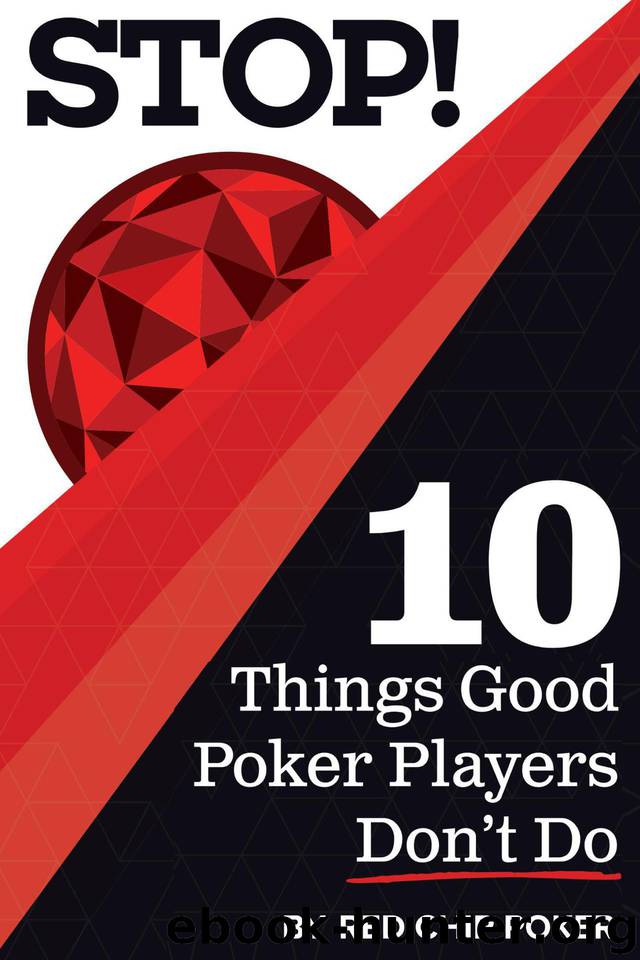STOP! 10 Things Good Poker Players Don't Do by Doug Hull & Christian Soto & James Sweeney & Ed Miller

Author:Doug Hull & Christian Soto & James Sweeney & Ed Miller [Hull, Doug]
Language: eng
Format: mobi
Published: 2015-10-07T16:00:00+00:00
.
S TOP PAYING THEM OFF BY MILLER
This concept is simple but powerful. It’s based on a strategic idea that applies nearly universally in small stakes no-limit hold’em games. When people make big bets and raises on the turn and river, they aren’t bluffing.
It’s not that they never bluff. But there is a theoretical percentage of the time that players should be bluffing if they want to play well. In nearly all cases, small stakes players will fall short of this theoretical percentage with their bluffing when the big bets come out. They bluff— but they don’t bluff often enough to make you want to call.
Therefore, if someone makes a big bet or raise, you should assume they have the hand they are representing. This usually means you should fold.
If you should fold, you should fold. Every time.
That’s the hard part. It’s easy to talk yourself into calling. Maybe you feel like you’re being bullied, so you decide you’re going to take a stand. (At $1-$2, it’s more likely you’re just running bad than that your opponent is intentionally manipulating you.)
Maybe you flopped a big hand, and you just can’t accept that you were outdrawn.
Maybe it’s not clear what your opponent is representing, and you are confused or curious.
I don’t care. Fold. Learning to fold in these situations is one of the skills most critical to beating $1-$2 games.
Here’s an example. It’s a $1-$2 game. You have A-K. Two players limp, and you make it $12 to go. The big blind and one of the limpers calls. There’s $39 in the pot and $300 left in the stacks.
The flop comes A -8 -7 . Your opponents check, you bet $30, and the limper calls.
The turn is the 6 . Your opponent checks, you bet $80, and the limper calls again. There’s $259 in the pot and $190 left in the stacks.
The river is the Q . Your opponent shoves allin for $190.
Fold.
Fold. Fold. Fold.
Don’t think too hard about it. Just fold. The logic is simple.
First, would your opponent make this bet with a hand he’s not bluffing with, but that you beat? The best hand like that is A-J.
Would you shove all-in here if you had A-J? Or would you be very worried that your hand is no good? It can be dangerous to put yourself in your opponents’ shoes and assume they’ll play as you do, but in this circumstance almost no regular poker players would be thrilled to hold A-J. With that hand, they’d be approaching the river cautiously. An all-in shove is not cautious.
So if we can essentially discard the idea that your opponent is betting a hand slightly worse than yours, there are two options. He could be bluffing. Or he could have you beat.
Up to the $2-$5 level, you should assume you’re beat and fold. Again, there’s a theoretical percentage of the time your opponent has to be bluffing to make it worthwhile to try to bluff catch. In this hand, with these bet and pot sizes, that percentage is approximately 30 percent.
Download
This site does not store any files on its server. We only index and link to content provided by other sites. Please contact the content providers to delete copyright contents if any and email us, we'll remove relevant links or contents immediately.
Harry Potter and the Cursed Child: The Journey by Harry Potter Theatrical Productions(3955)
The Sports Rules Book by Human Kinetics(3582)
Molly's Game: From Hollywood's Elite to Wall Street's Billionaire Boys Club, My High-Stakes Adventure in the World of Underground Poker by Molly Bloom(2962)
A Knight of the Seven Kingdoms by George R R Martin(2620)
Quidditch Through the Ages by J.K. Rowling(2567)
Quidditch Through the Ages by J K Rowling & Kennilworthy Whisp(2557)
How To by Randall Munroe(2466)
Quidditch Through the Ages by Kennilworthy Whisp by J.K. Rowling(2404)
Quidditch through the Ages by J. K. Rowling(2351)
Quidditch Through The Ages by J. K. Rowling(2314)
Stacked Decks by The Rotenberg Collection(2267)
776 Stupidest Things Ever Said by Ross Petras(2264)
What If?: Serious Scientific Answers to Absurd Hypothetical Questions by Randall Munroe(2166)
Flowers For Algernon by Daniel Keyes(2153)
The Infinite Retina by Robert Scoble Irena Cronin(2140)
Beautiful Oblivion by Jamie McGuire(2136)
The Book of Questions: Revised and Updated by Gregory Stock Ph.d(2136)
Champions of Illusion by Susana Martinez-Conde & Stephen Macknik(2073)
Ready Player One: A Novel by Ernest Cline(2071)
